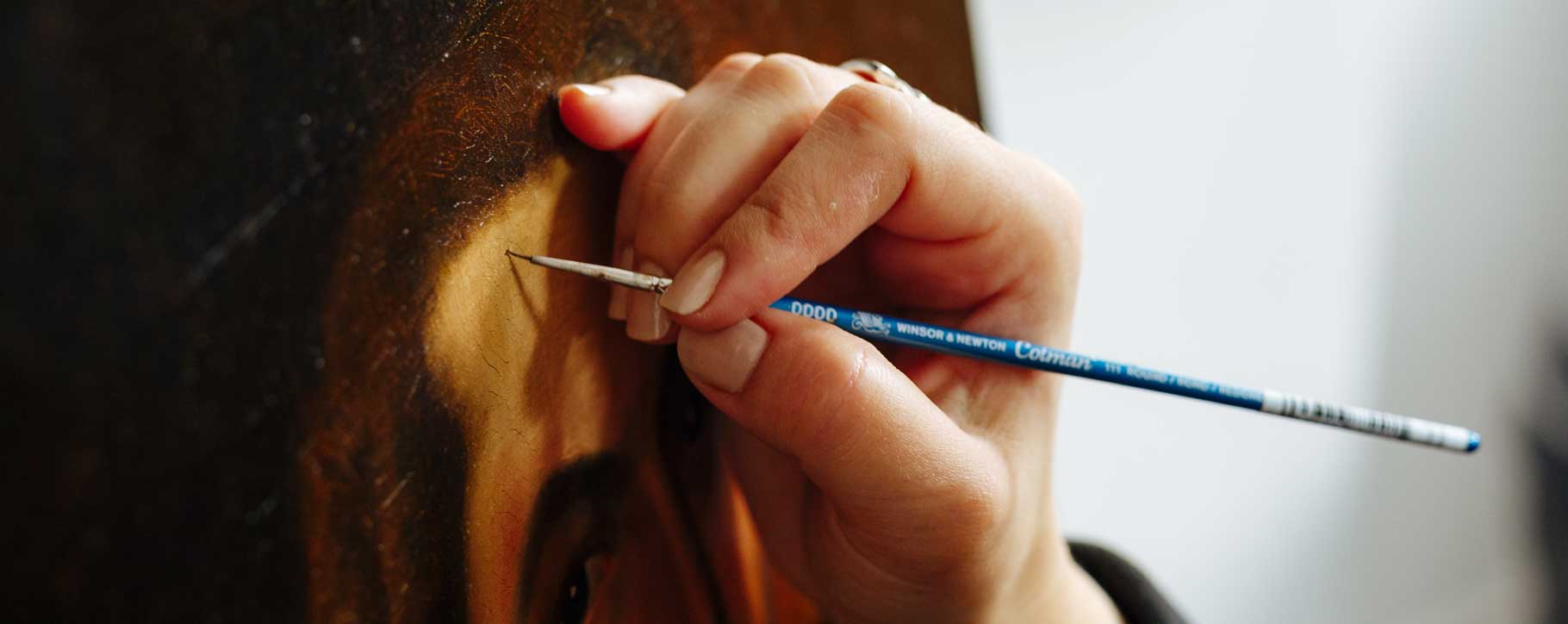Chiaroscuro (noun)
the use of areas of light and dark in an artwork to create dimension
One of the most effective and technical uses of colour in oil painting is known as chiaroscuro. This illuminating technique allows the artist to portray a sense of realism within their canvas, often focusing on a subject that allows them to experiment, such as a woman holding a candle or a heavenly light falling upon a religious subject.
 Above: a detail from an allegory with a boy lighting a candle by El Greco, 1580
Above: a detail from an allegory with a boy lighting a candle by El Greco, 1580
Due to the selective use of light, many paintings that use chiaroscuro have large areas of flat, dark pigment. This presents a challenge for care and restoration as it presents an easily disturbed shadow that does not easily hide disturbances in the same way a busy, colourful painting would. Secondly, dark pigments from the late 18th century and early 19th century often included a tar-like additive called bitumen, a substance that does not age well and may cause major visual concerns.
 Above: a genre painting before and after restoration in our studio
Above: a genre painting before and after restoration in our studio
This article will look into the history of chiaroscuro, as well as the common problems you may come across in caring for these artworks. We will also feature some of the successful restorations that have been completed in our studio, all of which required a highly sensitive approach.
 Above: a detail from Caravaggio’s Sacrifice of Isaac from 1603
Above: a detail from Caravaggio’s Sacrifice of Isaac from 1603
Chiaroscuro history & famous artists
Although ‘light modelling’ has roots in ancient history, the beginnings of chiaroscuro as it is recognised today stem back to the preparatory drawings used by artists in the renaissance period. During the 16th century, it was commonplace for paintings to be based on sketches that used white gouache upon a darker base to build up the use of light on a body or three-dimensional object. This approach helped the artist to model the way in which the final artwork would be layered in terms of proportion and perspective, making chiaroscuro drawings an effective tool for both painters and sculptors.
 Above: a selection of 16th century chiaroscuro studies by Pordenone, Altdorfer and Niccolò dell’Abate
Above: a selection of 16th century chiaroscuro studies by Pordenone, Altdorfer and Niccolò dell’Abate
In western art history, the inspiration for chiaroscuro is connected to Christian imagery. 14th century mystic Saint Bridget of Sweden famously envisioned the nativity scene with the Christ child emitting light, creating an artistic theme that can be found in depictions of this event through to the late 18th century. Whilst some artists approached the topic with the infant Jesus producing the heavenly light, others included items such as candles to give a sense of realism.
 Above: details from a nativity scene by Geertgen tot Sint Jans, 1490
Above: details from a nativity scene by Geertgen tot Sint Jans, 1490
Chiaroscuro became prevalent throughout the mannerism and baroque periods, but it was Carravaggio’s work that stands out as a dominant example with the use of light from an unseen source to create drama. Illumination in this way came to be known as Tenebrism, from the Italian word ‘tenebroso’ meaning dark, gloomy and mysterious.
 Above: a detail from The Denial of Saint Peter by Caravaggio, 1610
Above: a detail from The Denial of Saint Peter by Caravaggio, 1610
Renaissance artists who used chiaroscuro include:
- Leonardo da Vinci (1452-1519)
- Tintoretto (1518-1594)
- El Greco (1541-1614)
- Paolo Veronese (1528-1588)
- Albrecht Dürer (1471-1528)
- Caravaggio (1571-1610)
 Above: a detail from Saint Catherine of Alexandria in Prison by Veronese, 1580-85
Above: a detail from Saint Catherine of Alexandria in Prison by Veronese, 1580-85
During the 17th century, genre paintings began to use the topic of candlelight to produce visually stunning scenes of domestic life. This was particularly popular with Flemish and Dutch artists, many of which had connections to the Utrecht Caravaggisti – a group of Dutch artists inspired by Caravaggio after a trip to Rome. Rembrandt also famously uses chiaroscuro in his artworks, from both an unseen source or candlelight.
 Above: a detail from Rembrandt’s Aristotle with a Bust of Homer from 1653
Above: a detail from Rembrandt’s Aristotle with a Bust of Homer from 1653
Famous 17th century artists who used chiaroscuro include:
- Rembrandt van Rijn (1606-1669)
- Georges de La Tour (1593-1652)
- Gerard van Honthorst (1592-1656)
- Judith Leyster (1609-1660)
- Adam Elsheimer (1578-1610)
- Matthias Stom (1600-1650)
- Gerrit Dou (1613-1675)
- Artemisia Gentileschi (1593-1653)
- Adam de Coster (1586-1643)
- Trophime Bigot (1579-1650)
- Godfried Schalcken (1643-1706)
 Above: The Penitent Magdalen by Georges de La Tour from 1640
Above: The Penitent Magdalen by Georges de La Tour from 1640
The baroque period used dramatic lighting as a way to express divine light in depictions of mythological and religious tales. During the 18th century and early 19th century, chiaroscuro was used expressively by numerous famous names, it can be found in the grand rococo works of Fragonard and the fêtes galantes of Watteau, often using the nature and idyllic pastoral settings as a dynamic backdrop to brightly lit figures. Henry Fuseli heavily used chiaroscuro to depict fantastical scenes, including his masterpiece The Nightmare.
 Above: a detail from The Stolen Kiss by Jean Honoré Fragonard, 1760
Above: a detail from The Stolen Kiss by Jean Honoré Fragonard, 1760
18th century and 19th century artists who used chiaroscuro include:
- Joseph Wright of Derby (1734-1797)
- Jean-Antoine Watteau (1684-1721)
- Jean-Honoré Fragonard (1732-1806)
- Thomas Lawrence (1769-1830)
- Joshua Reynolds (1723-1792)
- Henry Fuseli (1741-1825)
- Eugène Delacroix (1798-1863)
- Francisco Goya (1746-1828)
 Above: a detail from Henry Fuseli’s The Night-Hag Visiting Lapland Witches, 1796
Above: a detail from Henry Fuseli’s The Night-Hag Visiting Lapland Witches, 1796
In England, chiaroscuro as a central feature in oil painting is most often connected to Joseph Wright of Derby, who used societal developments and new technology as centrepieces to a dominant light. This produced an important contrast in art between the early use of heavenly light upon religious subjects and a new age of enlightenment that focused on scientific advancements. Notable masterpieces include A Philosopher Giving that Lecture on an Orrery from 1766 and An Experiment on a Bird in the Air Pump from 1768.
 Above: a detail from The Weeders by Jules Breton, 1868
Above: a detail from The Weeders by Jules Breton, 1868
You may also come across chiaroscuro in late 19th century and 20th century art, but it is often not referred to in such a way unless the use of light and dark is a dominant feature that overpowers the composition. You may find it in hyperrealistic contemporary art, but the genre of realism is often more of a focus than the chiaroscuro itself.
 Above: a detail from Self-Portrait at Spurveskjul by Vilhelm Hammershøi, 1911
Above: a detail from Self-Portrait at Spurveskjul by Vilhelm Hammershøi, 1911
The complex care of chiaroscuro paintings
Whilst many historic oil paintings have a wide variety of colours and many visual elements in their composition, an artwork with a large area of black or dark shadow can rarely hide age-related and atmospheric disturbances. Cracks that show the ground layer (often a chalky white) or canvas can create an extreme level of visual disturbance.
 Above: a detail of a painting in our studio before the restoration of a cracked surface
Above: a detail of a painting in our studio before the restoration of a cracked surface
The prevalence of cracking can be lessened in some cases with controlled environmental conditions, it is likely that a thin layer of craquelure will emerge on any painting over time due to the subtle expansion and contraction or movement of the canvas. If you are concerned about visual disturbances caused by cracking or an unstable paint layer, this will require professional intervention from our oil painting conservators. If your painting is in a stable condition but you would like to prevent the chance of cracking, we recommend keeping your artwork in a steady environment of around 20 degrees with a 40% humidity level.
 Above: artworks on panel are vulnerable to changes in humidity, this artwork was fully restored in our studio following deterioration and breakage
Above: artworks on panel are vulnerable to changes in humidity, this artwork was fully restored in our studio following deterioration and breakage
To further preserve the painting, it should be safely displayed within a well-fitted frame. This is important as a loose frame may rub against the surrounding edges, causing obvious abrasions to the shadowed areas. Secondly, the canvas should be well-tensioned (not too loose, not too tight) to avoid accidental cracking or denting when the painting is touched or moved.
 Above: loose frames can lead to abrasions and deterioration of the canvas
Above: loose frames can lead to abrasions and deterioration of the canvas
The use of bitumen in dark pigments was dominant in the 18th and 19th centuries, this is problematic because it is an asphalte substance that rarely dries and remains unstable and sticky for hundreds of years after application. Severe darkening, cracking and disturbances can occur in bitumen areas of a composition, and it may cling onto atmospheric contaminants such as fireplace smoke and nicotine. It may also interact badly with the varnish over time, creating visually disturbing effects on top of the artwork. This layer can be further disturbed by amateur attempts to clean the surface of the painting at home. Due to the use of unstable pigments, we always recommend that artworks with large areas of black or brown are professionally cleaned and stabilised to ensure their ongoing safety.
 Above: a dark area on a landscape painting with areas of raised and uneven paint possibly caused by bitumen use
Above: a dark area on a landscape painting with areas of raised and uneven paint possibly caused by bitumen use
Unintended shadows
Our conservators often come across paintings that have become darkened over time due to the atmosphere or the ingredients found in historic varnish. Many of these artworks may appear to have a great amount of shadow, sometimes hiding entire portions of the composition.
 Above: some artworks, such as this one that was restored in our studio, may appear dark but are in fact bright following varnish removal
Above: some artworks, such as this one that was restored in our studio, may appear dark but are in fact bright following varnish removal
You can usually tell if a dark appearance is purposeful or not by the appearance of the lighter areas. If bright or white pigments seem to be trapped behind a yellow tone, this may be perishing varnish or nicotine. A dull or darkened appearance of what should be highlighted features may be caused by fireplace smoke or thick historic varnish that has deteriorated. You can tell if smoke or nicotine is present by smelling the painting, as these particles will often give off a strong aroma. Our team can safely remove this surface disruption and return the artwork to its original appearance, as intended by the artist.
 Above: this painting was contaminated with smoke and had very thick, yellowing historic varnish – after restoration in our studio new features and colours were revealed
Above: this painting was contaminated with smoke and had very thick, yellowing historic varnish – after restoration in our studio new features and colours were revealed
Chiaroscuro painting restoration
In our studio, oil painting conservators are often faced with artworks that have been accidentally damaged or have become disturbed due to old age and historic environments. The first treatment performed on a painting is usually a sensitive surface clean to expel any contaminants. This is followed by a varnish removal with bespoke solvents, tested to the sensitivity of the painting.
 Above: a small area professionally cleaned to show the contrast that can be achieved when a painting is discoloured or contaminated
Above: a small area professionally cleaned to show the contrast that can be achieved when a painting is discoloured or contaminated
Varnish removal allows our team to reveal the true colours of an artwork, as they have often become hidden behind yellowing, historic varnish. This process also lessens the visual impact of any restoration, as it ensures that there will be a smooth, even surface once the new protective varnish is applied. Surface disturbances such as staining and accidental spillages can be removed along with a varnish removal treatment.
Above: our conservators use UV torches to look for hidden areas, these are often found in darkened areas
Common restoration treatments for oil paintings in our studio include:
- Thread-by-thread tear repair
- Stabilisation of cracking or flaking paint
- Consolidation of the paint layer including loose paint
- Re-lining canvas if there are signs of de-lamination or weak areas
- Stabilisation of stretcher bars and canvas
- Frame restoration including gilding and stabilisation
- New varnish to lessen the shine or to provide a non-yellowing surface
- Canvas re-tensioning
- Flattening of a dented or disturbed canvas
- Water damage restoration including mould growth elimination
- Fire and smoke damage restoration
- Removal of stains and surface disturbances
 Above: a painting with use of chiaroscuro before and after restoration in our studio
Above: a painting with use of chiaroscuro before and after restoration in our studio
A painting with large areas of shadow may also benefit from an adjustment of varnish. This is due to a high-shine varnish allowing for reflections, obscuring the impact of a dark scene. Our team can customise a varnish to suit the needs of your painting, from satin to matt finishes. These will also provide UV protection and will not turn yellow like traditional varieties.
 Above: a painting is retouched with a very small and precise brush and conservation-friendly pigments
Above: a painting is retouched with a very small and precise brush and conservation-friendly pigments
Cracking paint layers or areas of missing flaking paint can have disturbed areas filled and retouched with sympathetic pigments. The new colour is carefully applied with a pin-sized amount on the end of a tiny paintbrush between two layers of isolating varnish, this is because our conservators always opt for as little intervention as possible to allow for historic and artistic integrity. This type of restoration only takes place if it is required for the ongoing safety of the artwork, small areas of stable craquelure are usually left untouched as this is part of natural ageing.
How can we help?
If you have a painting that may benefit from professional restoration, please contact our helpful team for further advice and an assessment.
You can get in touch by emailing [email protected] or call 0207 112 7576 for a conversation about our services.
You might also be interested in:

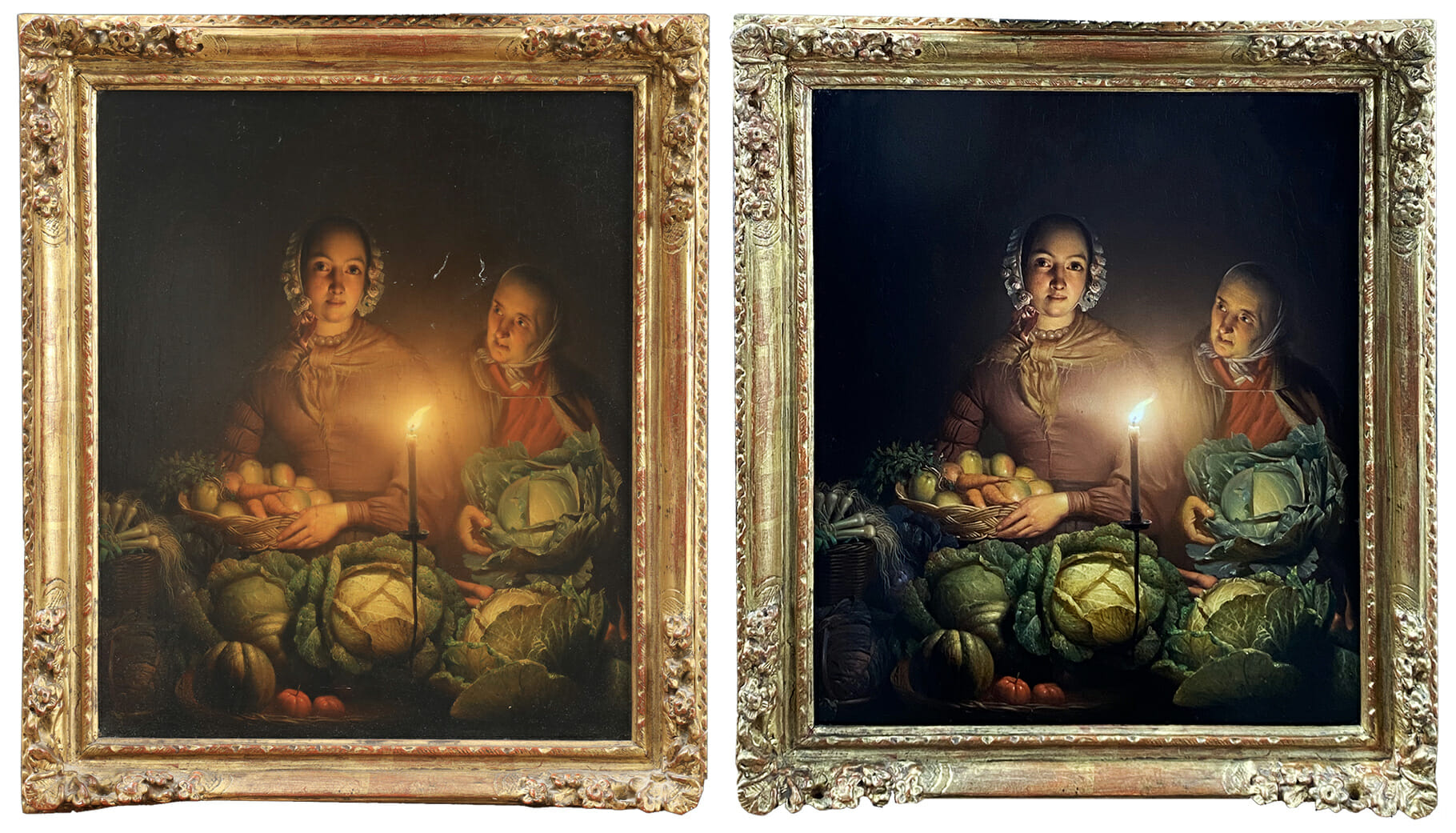
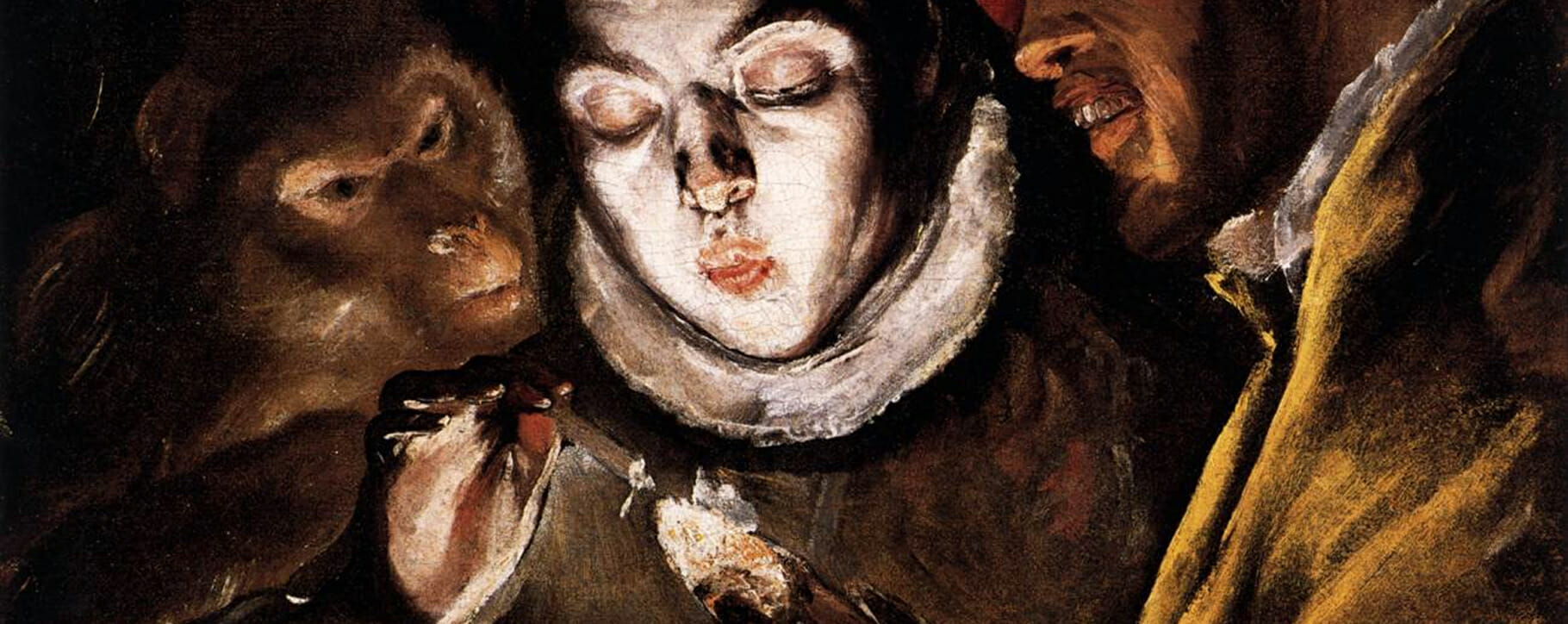 Above: a detail from an allegory with a boy lighting a candle by El Greco, 1580
Above: a detail from an allegory with a boy lighting a candle by El Greco, 1580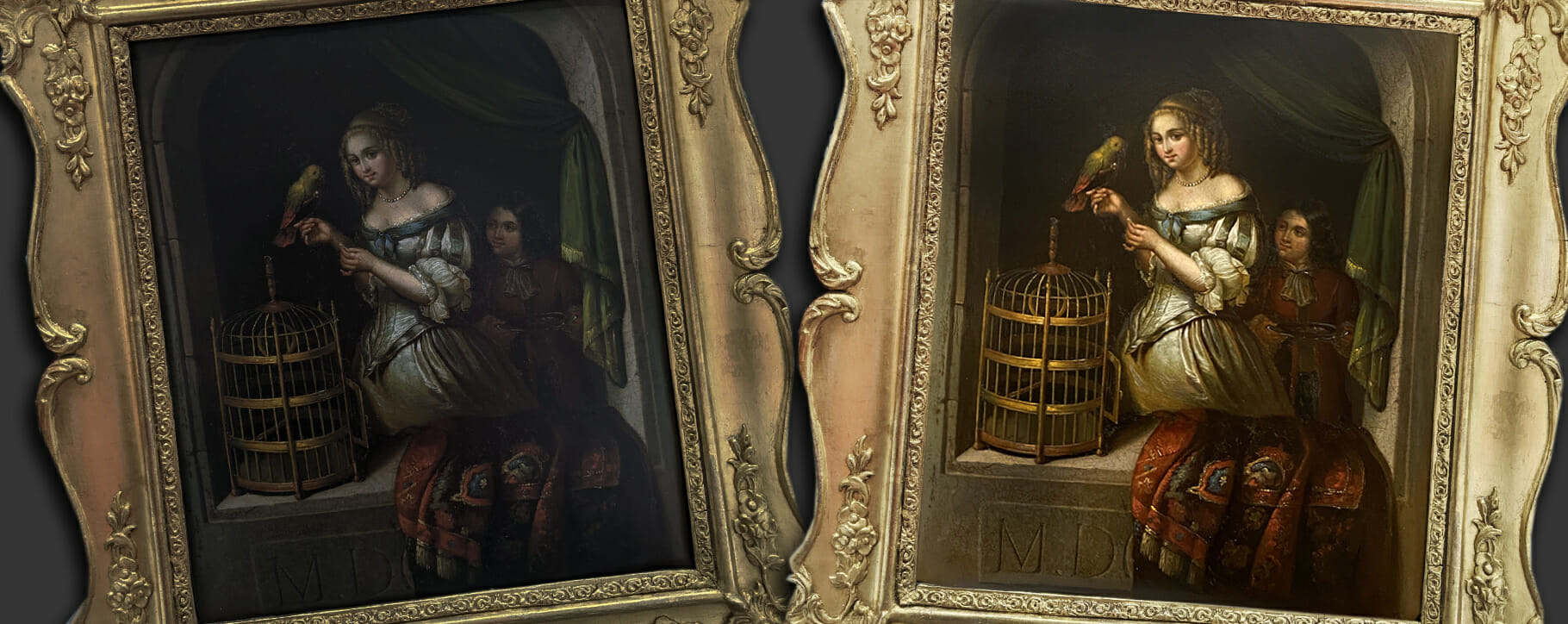 Above: a genre painting before and after restoration in our studio
Above: a genre painting before and after restoration in our studio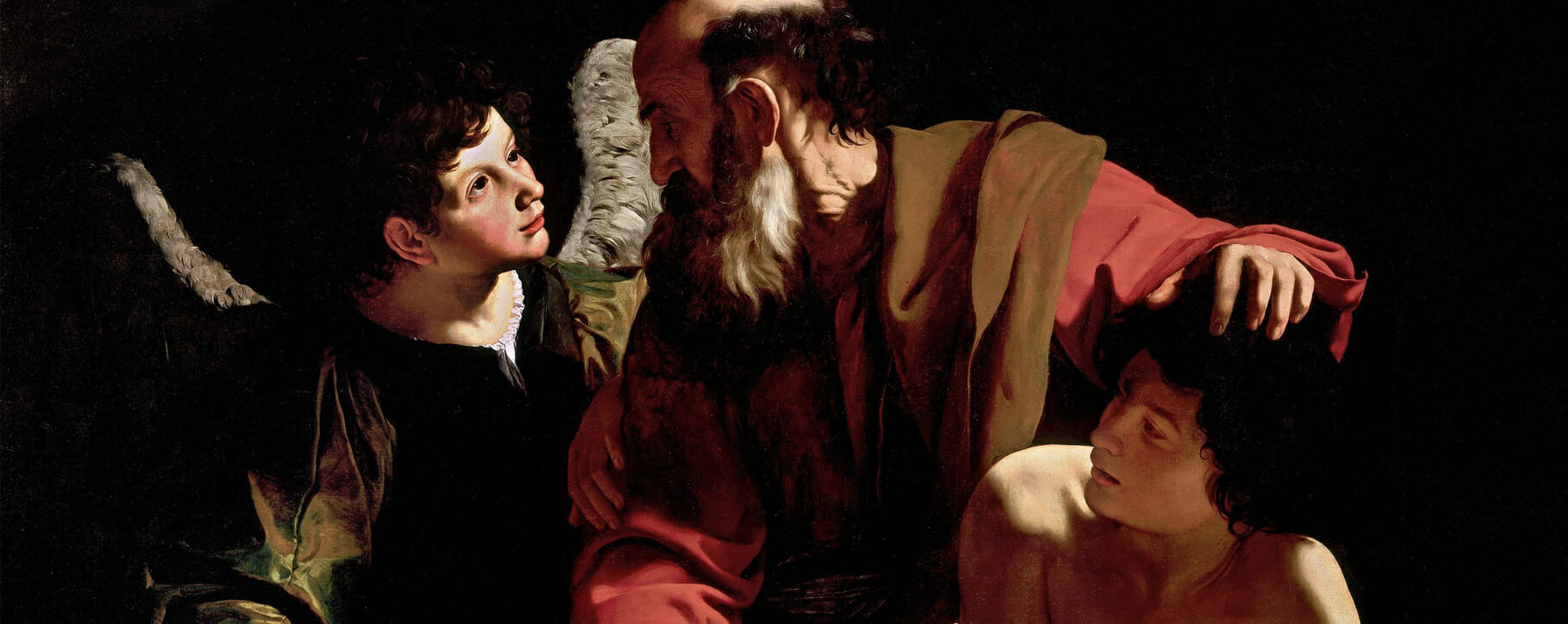 Above: a detail from Caravaggio’s Sacrifice of Isaac from 1603
Above: a detail from Caravaggio’s Sacrifice of Isaac from 1603 Above: a selection of 16th century chiaroscuro studies by Pordenone, Altdorfer and Niccolò dell’Abate
Above: a selection of 16th century chiaroscuro studies by Pordenone, Altdorfer and Niccolò dell’Abate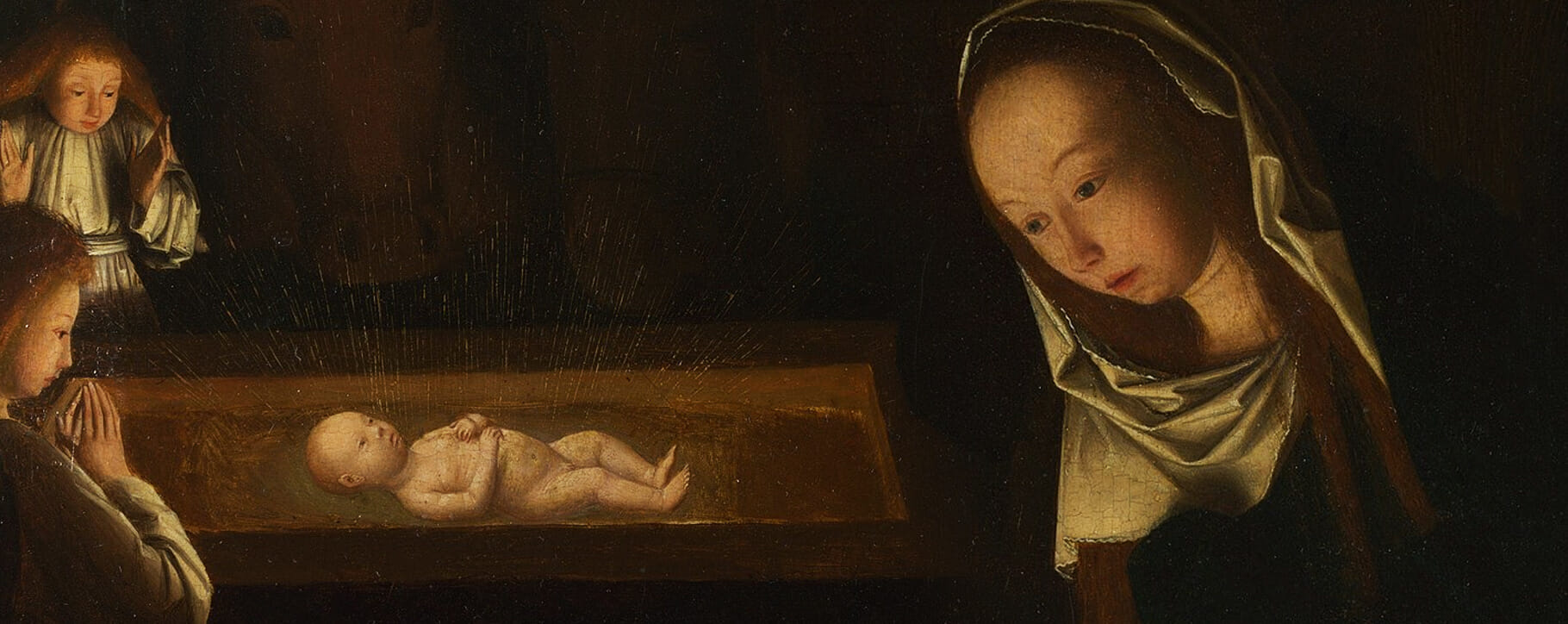 Above: details from a nativity scene by Geertgen tot Sint Jans, 1490
Above: details from a nativity scene by Geertgen tot Sint Jans, 1490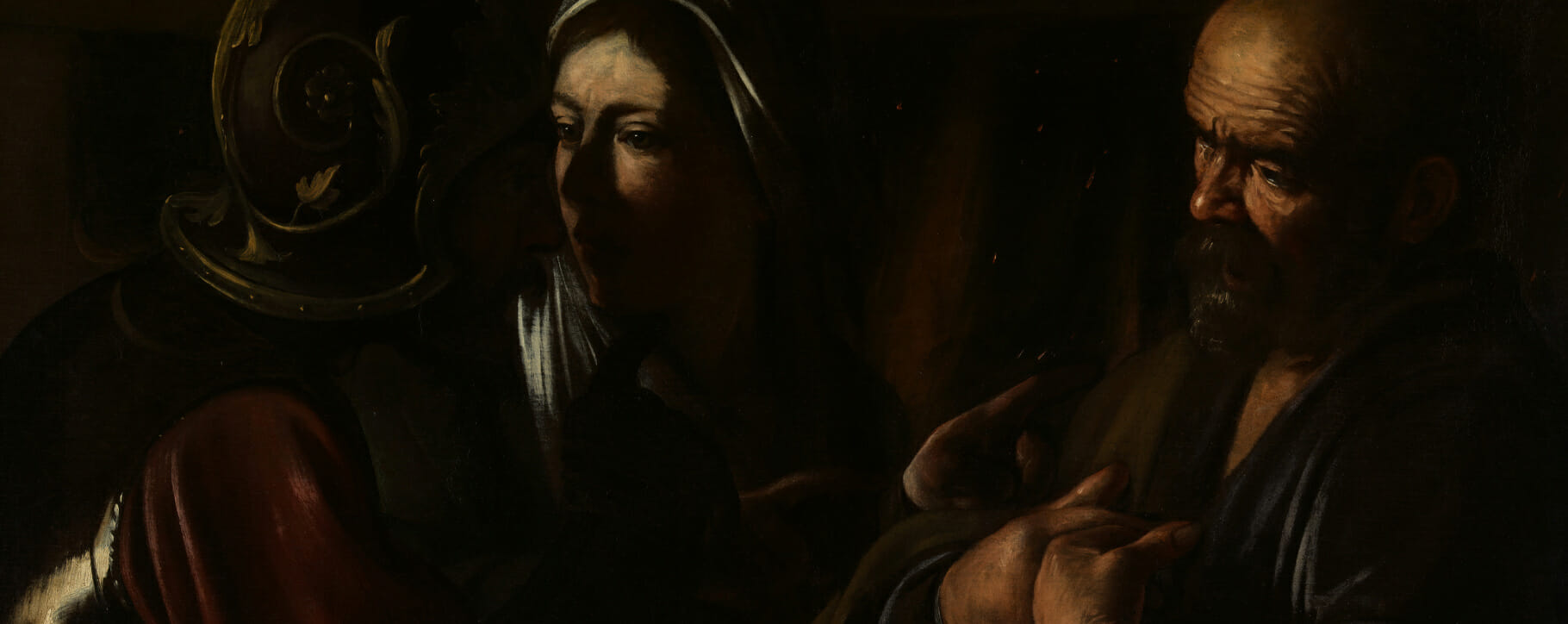 Above: a detail from The Denial of Saint Peter by Caravaggio, 1610
Above: a detail from The Denial of Saint Peter by Caravaggio, 1610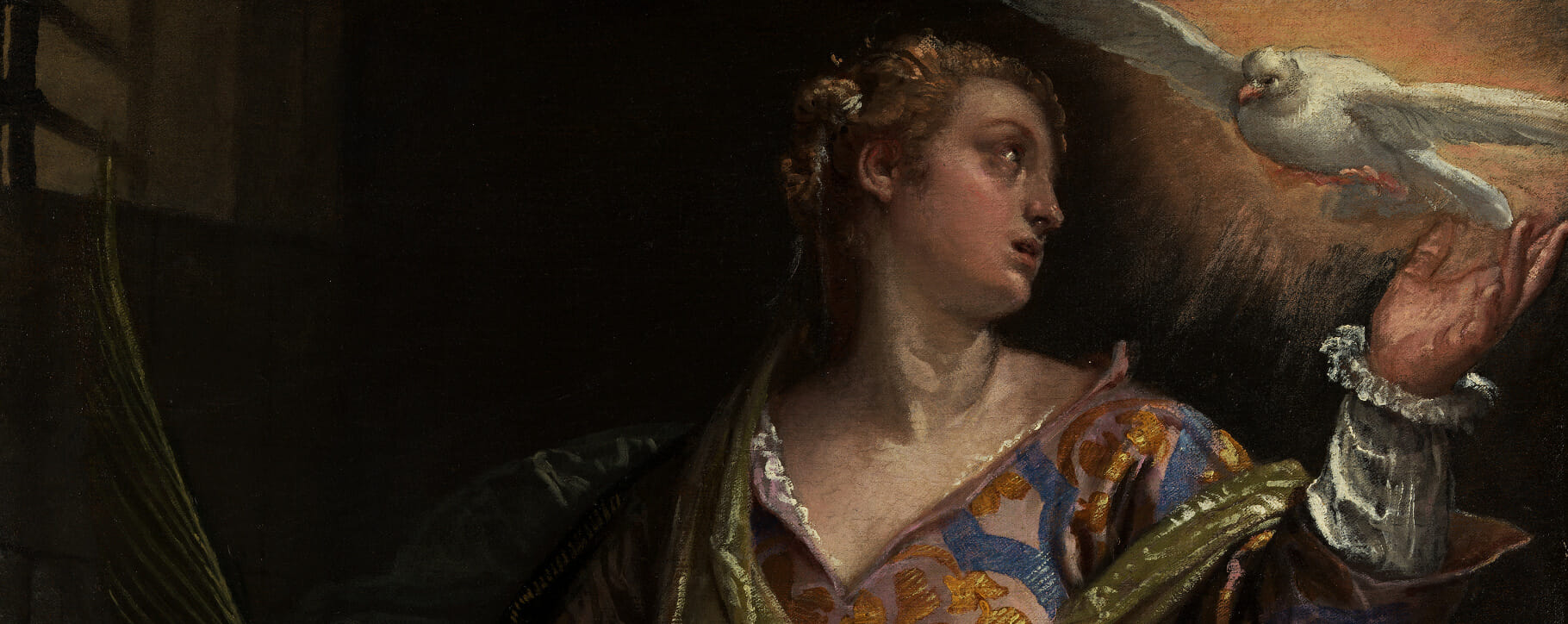 Above: a detail from Saint Catherine of Alexandria in Prison by Veronese, 1580-85
Above: a detail from Saint Catherine of Alexandria in Prison by Veronese, 1580-85 Above: a detail from Rembrandt’s Aristotle with a Bust of Homer from 1653
Above: a detail from Rembrandt’s Aristotle with a Bust of Homer from 1653 Above: The Penitent Magdalen by Georges de La Tour from 1640
Above: The Penitent Magdalen by Georges de La Tour from 1640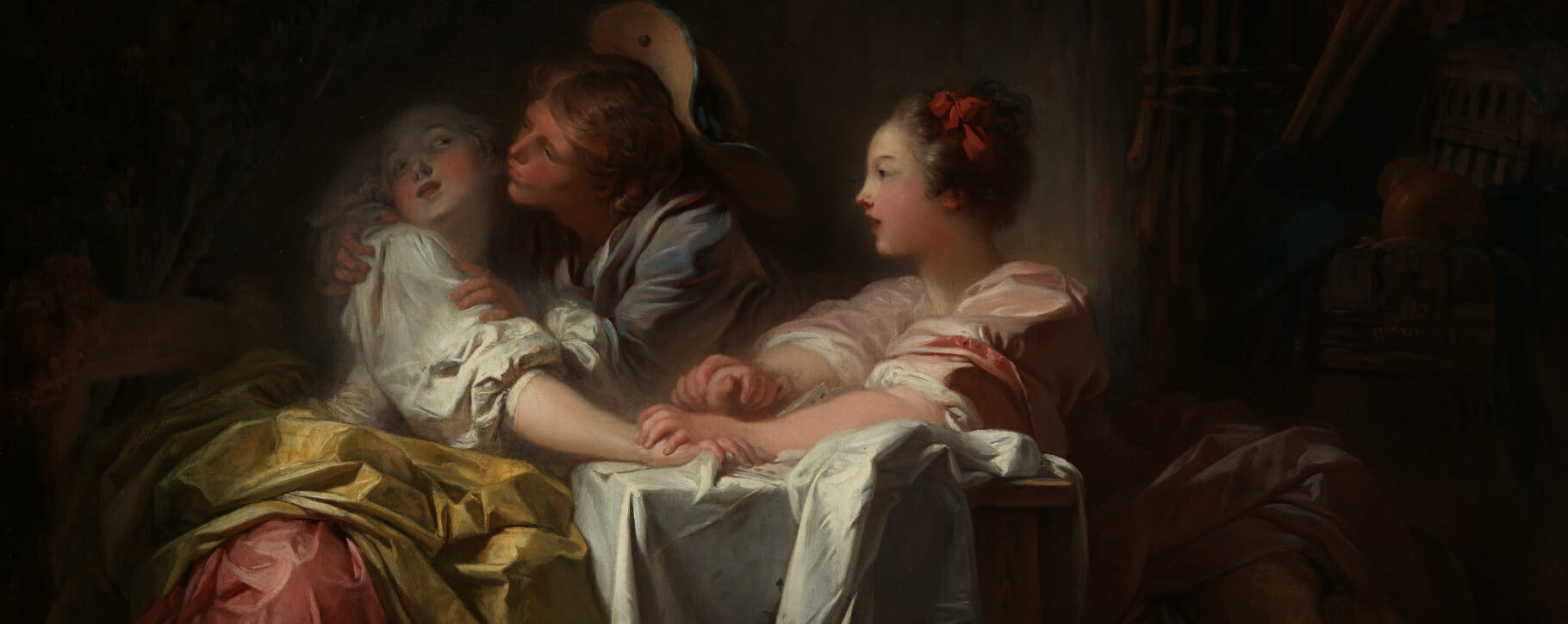 Above: a detail from The Stolen Kiss by Jean Honoré Fragonard, 1760
Above: a detail from The Stolen Kiss by Jean Honoré Fragonard, 1760  Above: a detail from Henry Fuseli’s The Night-Hag Visiting Lapland Witches, 1796
Above: a detail from Henry Fuseli’s The Night-Hag Visiting Lapland Witches, 1796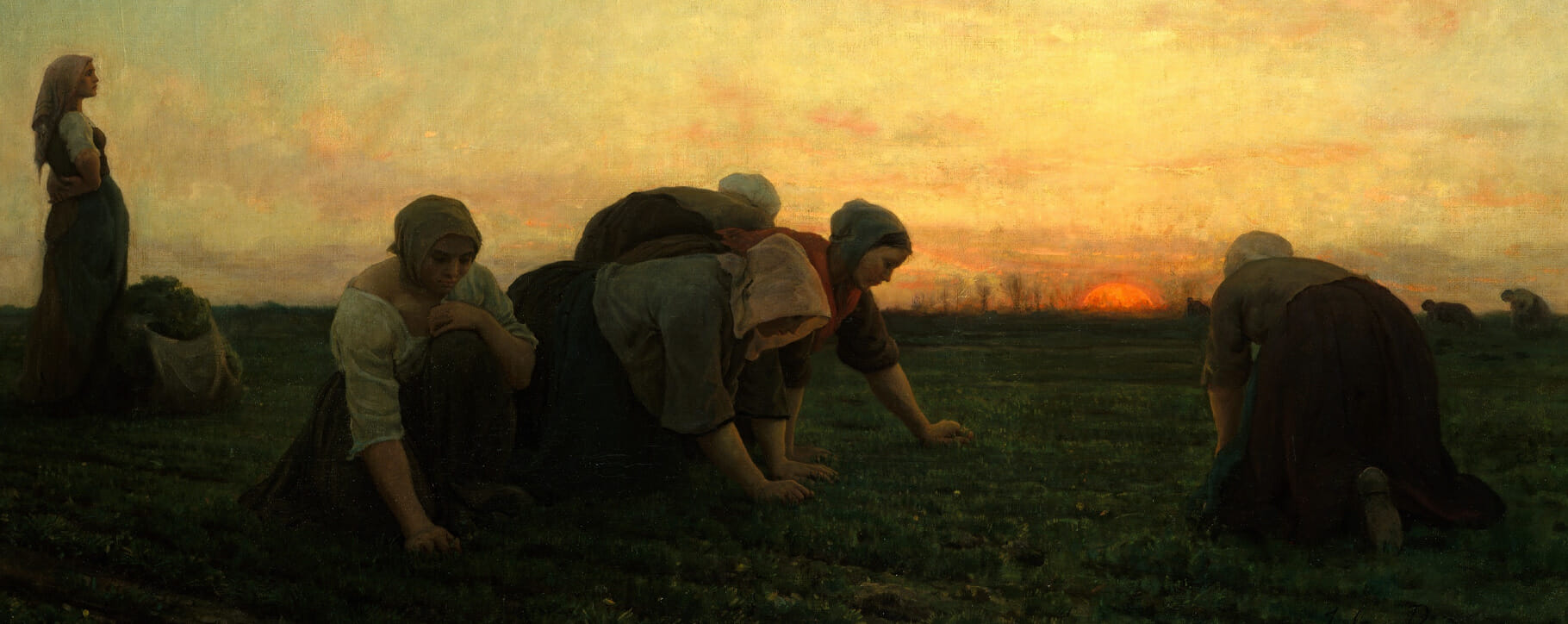 Above: a detail from The Weeders by Jules Breton, 1868
Above: a detail from The Weeders by Jules Breton, 1868 Above: a detail from Self-Portrait at Spurveskjul by Vilhelm Hammershøi, 1911
Above: a detail from Self-Portrait at Spurveskjul by Vilhelm Hammershøi, 1911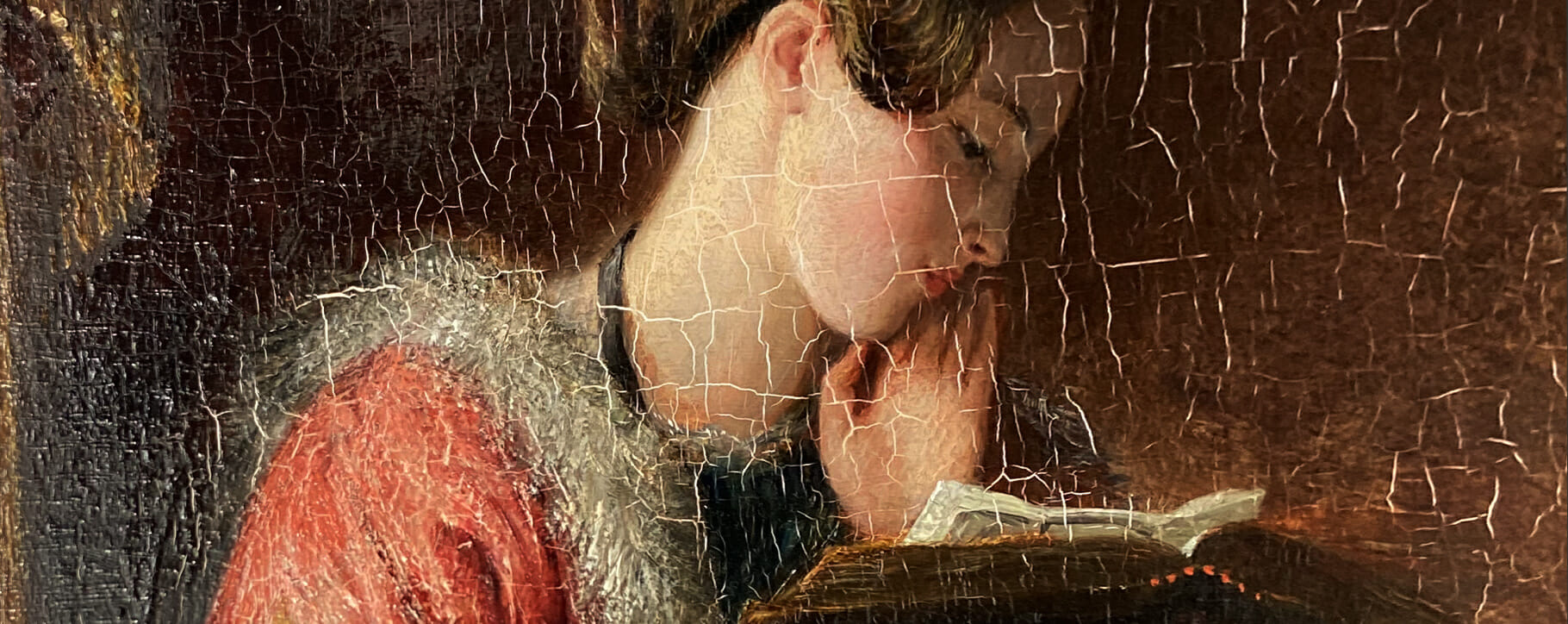 Above: a detail of a painting in our studio before the restoration of a cracked surface
Above: a detail of a painting in our studio before the restoration of a cracked surface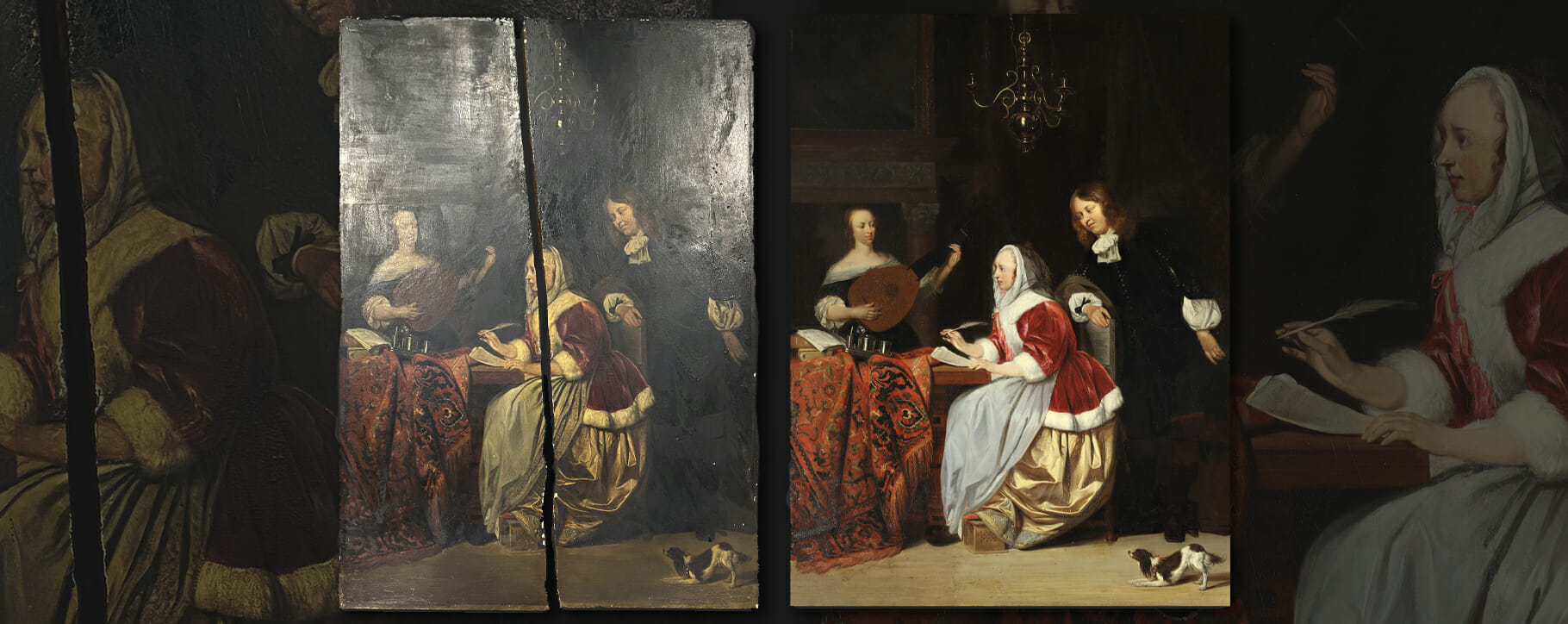 Above: artworks on panel are vulnerable to changes in humidity, this artwork was fully restored in our studio following deterioration and breakage
Above: artworks on panel are vulnerable to changes in humidity, this artwork was fully restored in our studio following deterioration and breakage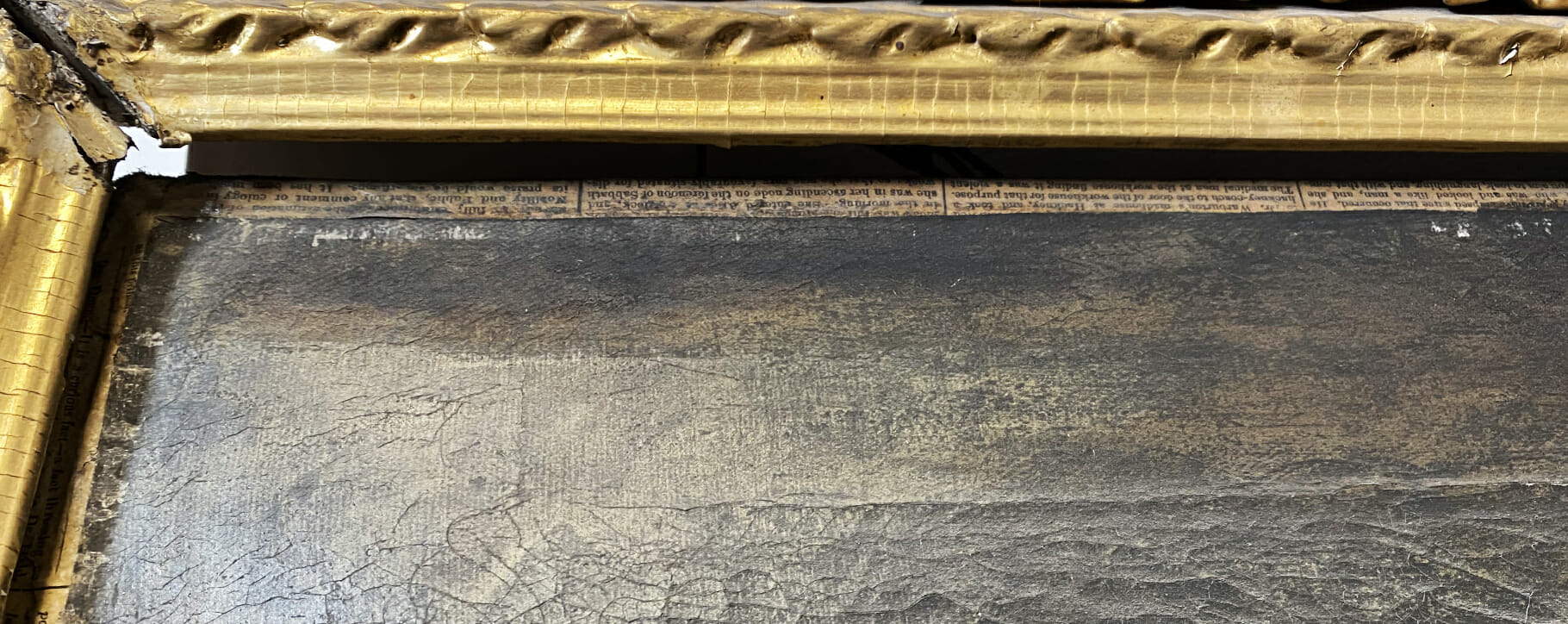 Above: loose frames can lead to abrasions and deterioration of the canvas
Above: loose frames can lead to abrasions and deterioration of the canvas Above: a dark area on a landscape painting with areas of raised and uneven paint possibly caused by bitumen use
Above: a dark area on a landscape painting with areas of raised and uneven paint possibly caused by bitumen use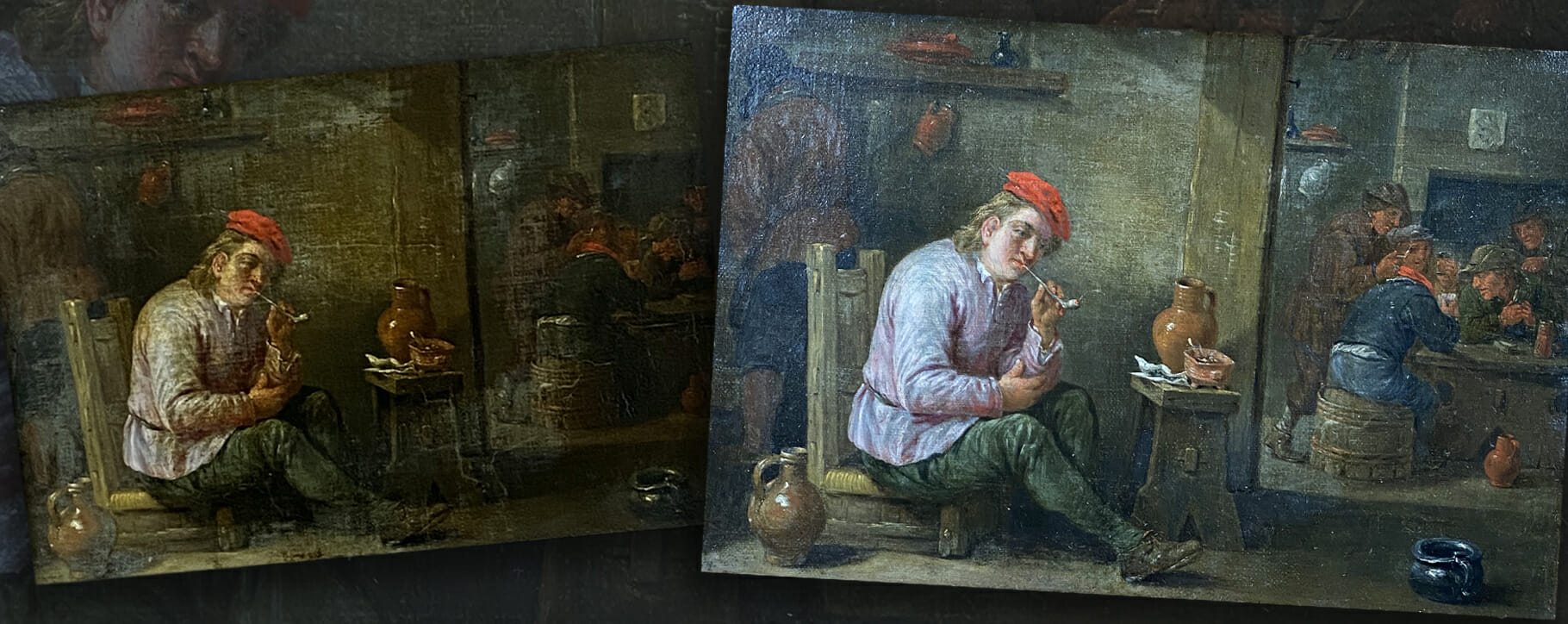 Above: some artworks, such as this one that was restored in our studio, may appear dark but are in fact bright following varnish removal
Above: some artworks, such as this one that was restored in our studio, may appear dark but are in fact bright following varnish removal Above: this painting was contaminated with smoke and had very thick, yellowing historic varnish – after restoration in our studio new features and colours were revealed
Above: this painting was contaminated with smoke and had very thick, yellowing historic varnish – after restoration in our studio new features and colours were revealed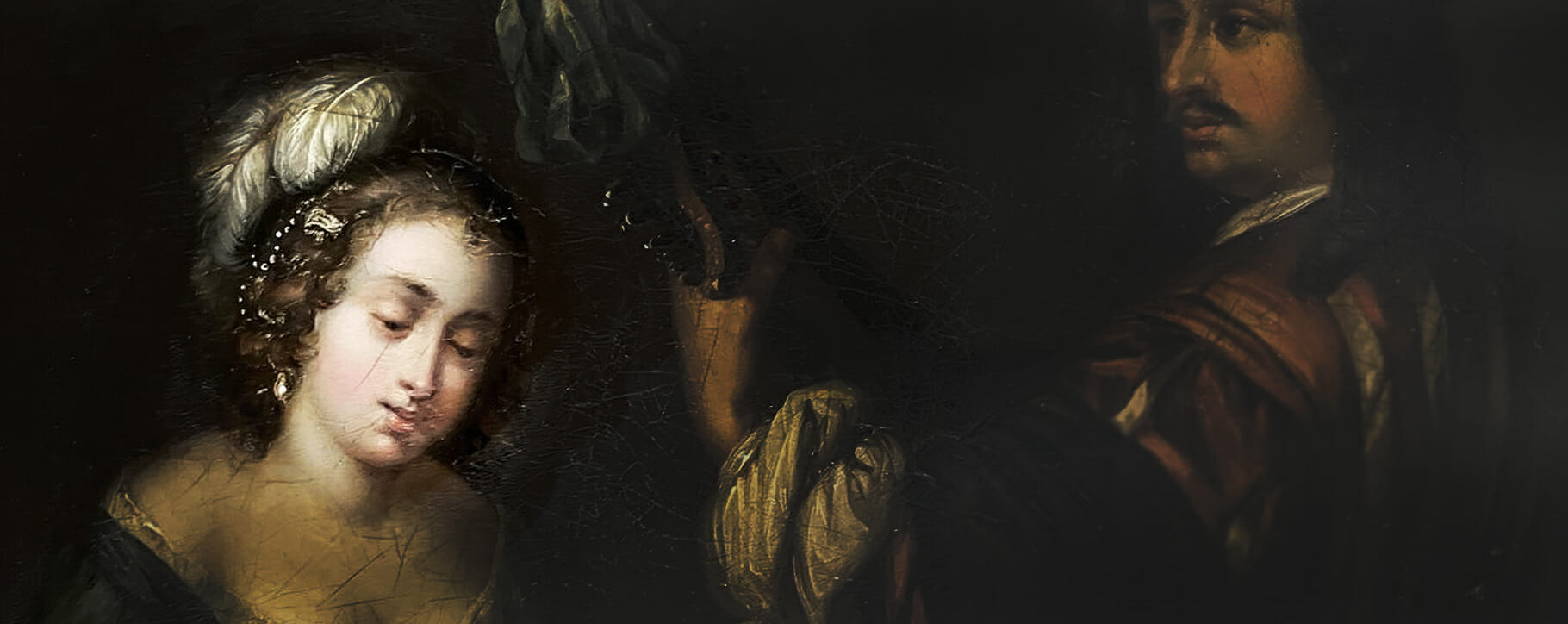 Above: a small area professionally cleaned to show the contrast that can be achieved when a painting is discoloured or contaminated
Above: a small area professionally cleaned to show the contrast that can be achieved when a painting is discoloured or contaminated Above: a painting with use of chiaroscuro before and after restoration in our studio
Above: a painting with use of chiaroscuro before and after restoration in our studio